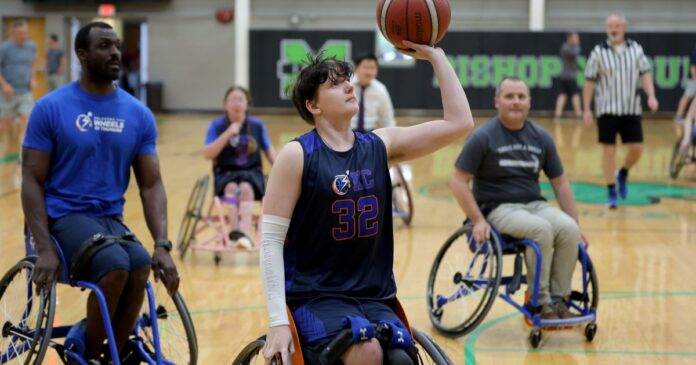Although wheelchair users, visually impaired people and others with mobility and physical disabilities need consistent exercise, it’s often hard for them to work out. In many cases, they can’t get access to “adaptive” exercise and sports equipment – meaning machines, weights and other devices that have been modified or engineered for ease of use by people with disabilities.
High costs, steep learning curves and limited access constrain their use.
MORE: Parenting has become so stressful that it’s now a public health issue, U.S. surgeon general warns
To reach that conclusion, I teamed up with Helara Wijesundara, who like me is a biomedical technologies researcher, to see what’s getting in their way. We published our findings in the Disability and Rehabilitation: Assistive Technology Journal in July 2024. We reviewed more than 40 products and over 20 articles that researchers have published on this topic.
Limited access
There are four kinds of adaptive fitness tools on the market: exercise equipment and accessories, exercise machines, sports equipment and fitness apps.
For instance, adaptive rowing machines, treadmills and similar kinds of equipment are easy to use and can help users track their fitness progress.
There is little data on how often adaptive exercise machines would be used if they were available in gyms, making gyms reluctant to purchase them. As a result, few gyms have any of these items, and most people can’t afford to buy their own because these machines can cost as much as $9,000.
Some adaptive exercise equipment, however, doesn’t cost nearly as much. For example, mono ropes, which are ropes attached to a bar that someone with one arm can use for jumping rope, generally cost about $100. Wheelchair tension bands, a portable system where you can attach resistant elastic bands with handles to a wheelchair to perform muscle strengthening workouts, are priced at about $150. Even though they can be easily purchased, these adaptive exercise tools are not found in most gyms.
In fact, this research was inspired by a conversation with members of the Movin’ Mavs, the University of Texas at Arlington’s championship-winning wheelchair basketball team. Those athletes said they have to be creative in order to overcome inconveniences at the gym.
For people who do not have training, working out becomes even more difficult without expert guidance. It can be easy to injure oneself without proper form or knowledge of how to use equipment safely, especially for someone with a disability.
Although there are inclusive fitness certifications available, most fitness instructors are not trained to adapt their knowledge to people with disabilities.
Also, there have been very few efforts to design digital fitness technology, such as adaptive exercise machines that connect with fitness game apps or virtual group exercise apps for people with disabilities.
But these features would be very useful, as they could help people learn how to exercise with a disability, build self-confidence and increase motivation.
Major health issue
The 13% of Americans who have disabilities are twice as likely to have diabetes, stroke and depression than the general population. This isn’t just because of disparities in access to health care or underlying conditions. It’s also because they get less exercise than they need.
Only about 1 in 4 U.S. adults meet recommended physical activity guidelines, which include getting at least 150 minutes of moderate-intensity physical activity per week and engaging in muscle-strengthening activities at least twice a week.
People with disabilities are even less likely to meet those guidelines: Fewer than 1 in 10 adults with mobility disabilities are getting the recommended amounts of exercise.
Some fear being injured. Others say they don’t know how to work out or are too self-conscious to do it in public space. Most gym exercise machines are not accessible, and asking for help to use them may make some feel uncomfortable.
Getting to and from gyms can be difficult for some people with disabilities, especially for those in rural areas, where gyms are unlikely to have accessible options.
Adaptive fitness solutions have the potential to improve overall physical and mental health, reduce social isolation, prevent disease and drive societal change toward accessibility. Yet, insurance companies will cover the cost of personal adaptive exercise equipment and enrollment in programs only with a doctor’s note.
Next steps
Researchers still don’t know how people with physical and mobility disabilities are learning about new adaptive exercise tools and gaining access to them.
And despite recent progress in exercise technology, making exercise equipment that’s appropriate for people with physical disabilities remains an afterthought for designers.
That’s why my research team is developing adaptive exercise machines that can be used by people of all abilities, combined with digital fitness technology to guide and track exercise performance. With the help of our team of engineers, researchers, people with disabilities and organizations serving people with disabilities, we will begin our first small pilot study in late 2024 to assess how well these machines work and to gain feedback for further development.
If anyone can use equipment that’s accessible for people with disabilities, it would lower costs, increase demand and justify purchasing them for communal gyms.
Alexandra Jamieson, Research Scientist of Biomedical Technologies, University of Texas at Arlington
This article is republished from The Conversation under a Creative Commons license. Read the original article.



